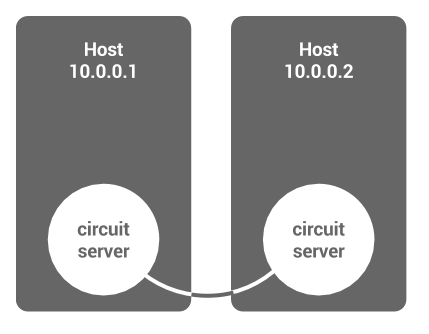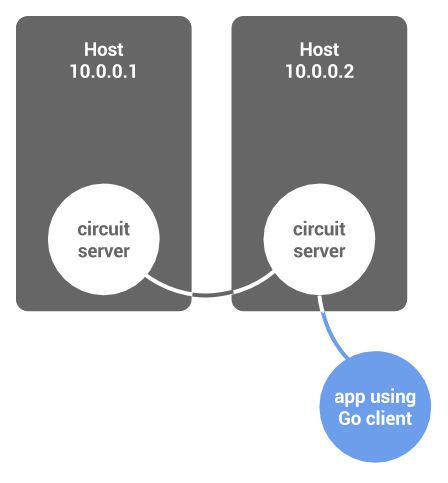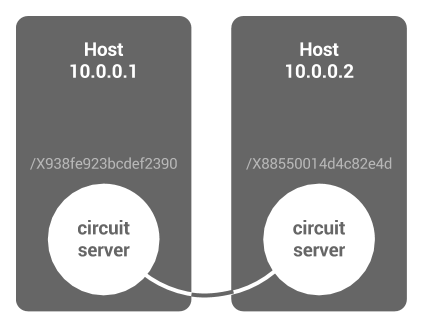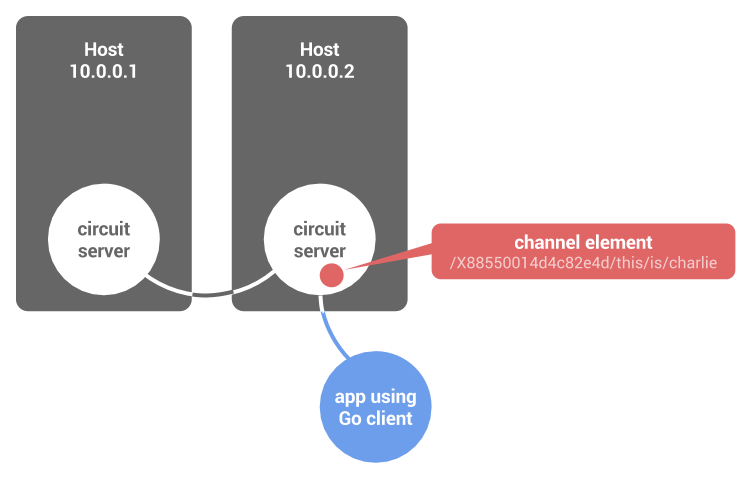 Directories
¶
Directories
¶
| Path | Synopsis |
|---|---|
|
Package client provides access to the circuit programming environment to user programs.
|
Package client provides access to the circuit programming environment to user programs. |
|
cmd
|
|
|
circuit
This package provides the executable program for the resource-sharing circuit app
|
This package provides the executable program for the resource-sharing circuit app |
|
element
|
|
|
_mesos
Package mesos provides the mesos element which serves as a real-time resource megotiation exchange inspired by Apache Mesos.
|
Package mesos provides the mesos element which serves as a real-time resource megotiation exchange inspired by Apache Mesos. |
|
github.com
|
|
|
docopt/docopt
Package docopt parses command-line arguments based on a help message.
|
Package docopt parses command-line arguments based on a help message. |
|
miekg/dns
Package dns implements a full featured interface to the Domain Name System.
|
Package dns implements a full featured interface to the Domain Name System. |
|
gocircuit.org
|
|
|
Package kit contains various utility packages useful with the circuit
|
Package kit contains various utility packages useful with the circuit |
|
config
Package config facilitates parsing JSON data with $-style environment variable references
|
Package config facilitates parsing JSON data with $-style environment variable references |
|
debug
Package debug implements debugging utilities
|
Package debug implements debugging utilities |
|
debug/ctrlc
Package ctrlc has the side effect of installing a Ctrl-C signal handler that throws a panic
|
Package ctrlc has the side effect of installing a Ctrl-C signal handler that throws a panic |
|
debug/http
Package http contains implementation for various HTTP reporting endpoint
|
Package http contains implementation for various HTTP reporting endpoint |
|
debug/http/trace
Package trace has the side effect of installing HTTP endpoints that report tracing information
|
Package trace has the side effect of installing HTTP endpoints that report tracing information |
|
debug/kill
Package kill has the side effect of installing a KILL signal handler that throws a panic
|
Package kill has the side effect of installing a KILL signal handler that throws a panic |
|
fmt
Package fmt contains string formatting utilities
|
Package fmt contains string formatting utilities |
|
iomisc
Package iomisc implements miscellaneous I/O facilities
|
Package iomisc implements miscellaneous I/O facilities |
|
llrb
Package llrb provides a left-leaning red-black implementation of 2-3 balanced binary search trees
|
Package llrb provides a left-leaning red-black implementation of 2-3 balanced binary search trees |
|
lockfile
Package os provides application-level utilities that are implemented using OS facilities (like lock files)
|
Package os provides application-level utilities that are implemented using OS facilities (like lock files) |
|
module
Package module provides a mechanism for linking an implementation package to a declaration package
|
Package module provides a mechanism for linking an implementation package to a declaration package |
|
posix
Package posix provides a few POSIX-based facilities for local and remote scripting
|
Package posix provides a few POSIX-based facilities for local and remote scripting |
|
pty
Package pty provides functions for working with Unix terminals.
|
Package pty provides functions for working with Unix terminals. |
|
sched
Package sched contains primitives for scheduling
|
Package sched contains primitives for scheduling |
|
sched/limiter
Package limiter schedules job execution while maintaining an upper limit on concurrency
|
Package limiter schedules job execution while maintaining an upper limit on concurrency |
|
stat
Package stat implements facilities for storing distribution sketches and updating them
|
Package stat implements facilities for storing distribution sketches and updating them |
|
sync
Package sync provides various synchronization primitives
|
Package sync provides various synchronization primitives |
|
tele
Package tele implements Teleport Transport which can overcome network outages without affecting endpoint logic.
|
Package tele implements Teleport Transport which can overcome network outages without affecting endpoint logic. |
|
tele/hmac
Package hmac implements carrier transports over TCP using HMAC authentication and RC4 symmetric encryption.
|
Package hmac implements carrier transports over TCP using HMAC authentication and RC4 symmetric encryption. |
|
tele/limiter
Package limiter schedules job execution while maintaining an upper limit on concurrency
|
Package limiter schedules job execution while maintaining an upper limit on concurrency |
|
tele/tcp
Package tcp implements carrier transports over TCP.
|
Package tcp implements carrier transports over TCP. |
|
tele/trace
Package trace implements an ad-hoc tracing system
|
Package trace implements an ad-hoc tracing system |
|
x
Package x encloses utilities for cross-sharing various types.
|
Package x encloses utilities for cross-sharing various types. |
|
x/exec
Package exec facilitates remote execution of OS processes across workers
|
Package exec facilitates remote execution of OS processes across workers |
|
x/file
Package file provides ways to pass open files to across circuit runtimes
|
Package file provides ways to pass open files to across circuit runtimes |
|
x/io
Package io facilitates sharing io reader/writer/closers across workers.
|
Package io facilitates sharing io reader/writer/closers across workers. |
|
xor
Package xor implements a nearest-neighbor data structure for the XOR-metric.
|
Package xor implements a nearest-neighbor data structure for the XOR-metric. |
|
Package sys encloses the implementations of circuit modules
|
Package sys encloses the implementations of circuit modules |
|
acid
Package acid implements a built-in API that exposes debugging, profiling, monitoring, and other worker facilities
|
Package acid implements a built-in API that exposes debugging, profiling, monitoring, and other worker facilities |
|
lang
Package lang implements the language runtime
|
Package lang implements the language runtime |
|
lang/prof
Package prof implements internal profiling data structures
|
Package prof implements internal profiling data structures |
|
lang/types
Package types implements the runtime type system
|
Package types implements the runtime type system |
|
tele
Package tele implements the circuit/use/n networking module using Teleport Transport
|
Package tele implements the circuit/use/n networking module using Teleport Transport |
|
Package tissue is an efficient “social” protocol for maintaining mutual awareness and sharing resources amongs circuit workers.
|
Package tissue is an efficient “social” protocol for maintaining mutual awareness and sharing resources amongs circuit workers. |
|
tutorial
|
|
|
nodejs-using-mysql/start-app
This is a circuit application that starts a node.js key/value service backed by a MySQL server.
|
This is a circuit application that starts a node.js key/value service backed by a MySQL server. |
|
wait-all
WaitAll is a simple circuit application that starts a few worker processes and waits until all finish.
|
WaitAll is a simple circuit application that starts a few worker processes and waits until all finish. |
|
wait-first
WaitFirst is a simple circuit application that starts a few worker processes and waits until someone finishes.
|
WaitFirst is a simple circuit application that starts a few worker processes and waits until someone finishes. |
|
watchbot
Virus is a simple, mildly-resilient to failure mechanism that runs around a cluster and delivers its payload (a process execution), in a self-sustained fashion.
|
Virus is a simple, mildly-resilient to failure mechanism that runs around a cluster and delivers its payload (a process execution), in a self-sustained fashion. |
|
watchbot-with-chan
Virus is a simple, mildly-resilient to failure mechanism that runs around a cluster and delivers its payload (a process execution), in a self-sustained fashion.
|
Virus is a simple, mildly-resilient to failure mechanism that runs around a cluster and delivers its payload (a process execution), in a self-sustained fashion. |
|
Package use contains the programming interfaces exposed by the circuit module system
|
Package use contains the programming interfaces exposed by the circuit module system |
|
anchorfs
Package anchorfs exposes the programming interface for accessing the anchor file system
|
Package anchorfs exposes the programming interface for accessing the anchor file system |
|
circuit
Package circuit exposes the core functionalities provided by the circuit programming environment
|
Package circuit exposes the core functionalities provided by the circuit programming environment |
|
worker
Package worker is a facade for the circuit spawning mechanism module
|
Package worker is a facade for the circuit spawning mechanism module |
Click to show internal directories.
Click to hide internal directories.









